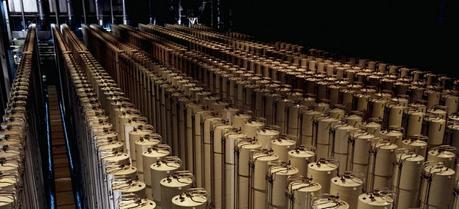 Cascade of gas centrifuges used to produce enriched uranium. This photograph is of a the U.S. gas centrifuge plant in Piketon, Ohio from 1984.
Cascade of gas centrifuges used to produce enriched uranium. This photograph is of a the U.S. gas centrifuge plant in Piketon, Ohio from 1984.
U.S. Photonics, Inc., a company specializing in ultrafast lasers, advanced motion control and material science, entered into a contract with TerraPower, LLC, to develop a method for manufacturing next generation nuclear components for TerraPower’s depleted uranium reactor (currently under development).
According to the TerraPower’s website, company’s depleted uranium reactor, or traveling wave reactor (TWR), builds upon many features of fast reactors designed in France, Japan, Germany, China, Russia and the United States. The TWR will able to operate for an extended period of time, using only depleted uranium (U-238) as fuel. This material is produced during the enrichment process, when enriched uranium (U-235) is separated from natural uranium. U-235 is the main fuel for today’s light water reactors, while U-238 is a by-product of the enrichment process and is currently set aside as waste.
TerraPower has performed detailed physics and engineering studies using advanced computational tools and is currently moving forward with plant design, component level development, and irradiation testing. The initial launch of the Traveling Wave Reactor is scheduled for 2022.
The major benefits of TWRs are that they can get high fuel utilization (enhancing sustainability) in a manner that does not require reprocessing and could eventually eliminate the need to enrich uranium. TWRs are designed to convert typically unusable fertile nuclides such as U-238 into fissile nuclides like Pu-239 in-situ and then shift the power from the highly-burned region to the freshly bred region. This allows the benefits of a closed fuel cycle without the expensive and proliferation-sensitive enrichment and reprocessing plants typically required to get them. All the fuel required for between 40 to 60 years of operation could be in the reactor from the beginning. Executives at TerraPower said that their depleted uranium reactor could even be buried below ground, where it could run for an estimated 100 years.
“US Photonics is proud to work with TerraPower,” said Jacob Conner, President. “Our team is currently working on innovative fabrication techniques for core components supporting TerraPower’s TWR design. Together, we are establishing American expertise in the field of new materials development. Our work is a critical piece in TerraPower’s effort to form a U.S.-based fast reactor supply chain. Moreover, our work brings practical value to our local community, providing key manufacturing jobs in Missouri and helping revitalize the American manufacturing industry.”

